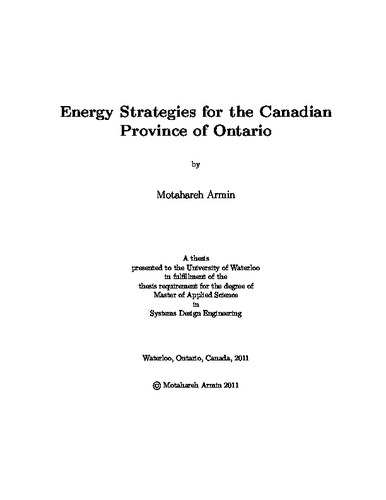| dc.description.abstract | The current and future energy situations in Canada are put into perspective, and the importance of nuclear energy and controversies surrounding it are investigated. More specifically, to demonstrate the important role nuclear energy has to play in Canada's future, a novel energy modeling tool, Canadian Energy Systems Simulator (CanESS), is employed. CanESS is a modeling platform with a huge database that assists an analyst in defining different energy scenarios by modifying the variables such as population and contributions of different energy sources to the overall production. The CanESS results clearly show that expansion of nuclear energy production is required to meet energy demand and simultaneously reduce greenhouse gas emissions.
To formally study strategic issues connected to the ongoing conflict over nuclear power production in Ontario, the Graph Model for Conflict Resolution (GMCR) is utilized. This flexible systems methodology is used to study the nuclear disputes that existed in Ontario at two key points in time: the fall of 2008 and spring of 2010. The results of the 2008 analysis, especially the sensitivity analyses, show that the only decision makers (DMs) involved in the conflict who hold real power are the Federal and Ontario governments, although at the beginning of the investigation the Atomic Energy of Canada Ltd. (AECL) and the environmental groups had also been considered as participating DMs. The findings and information of the analysis in 2008, as well as an updated background for 2010, are used to perform another analysis in 2010. Meanwhile, their options or possible courses of action have also been changed. Again, at this stage the stable states of the game are found, and attitude analysis is carried out to obtain deeper insights about the dispute. The equilibria or potential resolutions of the 2008 analysis are found to be the transition states in the 2010 analysis. Specifically, it is discovered that if the Federal Government does have a negative attitude towards the Ontario Government, it is possible that the final outcome is a state that is among the least preferred states for both DMs.
To formally study strategic issues connected to the ongoing conflict over nuclear power production in Ontario, the Graph Model for Conflict Resolution (GMCR) is utilized. This flexible systems methodology is used to study the nuclear disputes that existed in Ontario at two key points in time: the fall of 2008 and spring of 2010. The results of the 2008 analysis, especially the sensitivity analyses, show that the only decision makers (DMs) involved in the conflict who hold real power are the Federal and Ontario governments, although at the beginning of the investigation the Atomic Energy of Canada Ltd. (AECL) and the environmental groups had also been considered as participating DMs. The findings and information of the analysis in 2008, as well as an updated background for 2010, are used to perform another analysis in 2010. According to the results of the 2008 analysis, only the two governments are considered as the DMs in 2010. Meanwhile, their options or possible courses of action have also been changed. Again, at this stage the stable states of the game are found, and attitude analysis is carried out to obtain deeper insights about the dispute. The equilibria or potential resolutions of the 2008 analysis are found to be the transition states in the 2010 analysis. Specifically, it is discovered that if the Federal Government does have a negative attitude towards the Ontario Government, it is possible that the final outcome is a state that is among the least preferred states for both DMs. | en |

